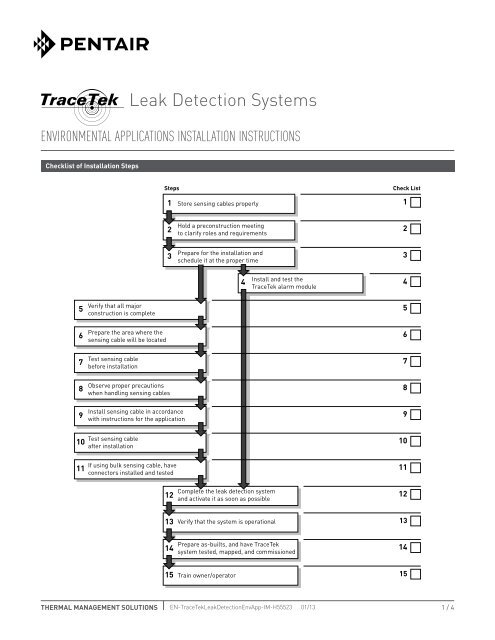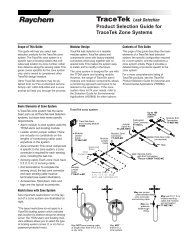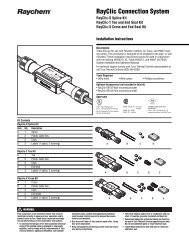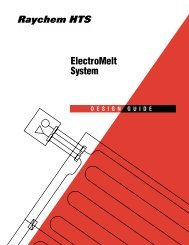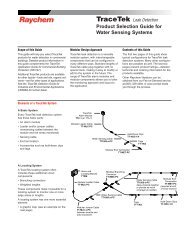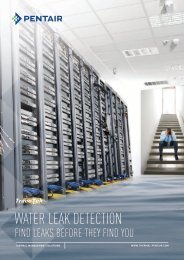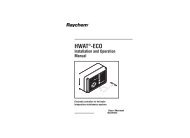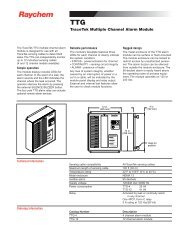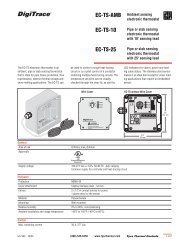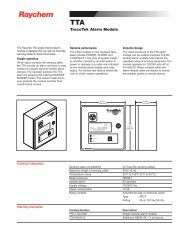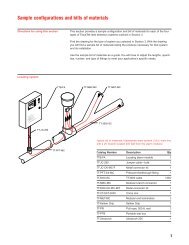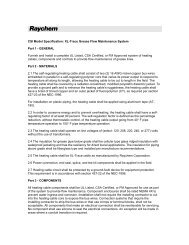Leak Detection Systems - Pentair Thermal Controls
Leak Detection Systems - Pentair Thermal Controls
Leak Detection Systems - Pentair Thermal Controls
You also want an ePaper? Increase the reach of your titles
YUMPU automatically turns print PDFs into web optimized ePapers that Google loves.
<strong>Leak</strong> <strong>Detection</strong> <strong>Systems</strong><br />
Environmental Applications Installation Instructions<br />
Checklist of Installation Steps<br />
Steps<br />
1<br />
Store sensing cables properly<br />
Check List<br />
1<br />
2<br />
Hold a preconstruction meeting<br />
to clarify roles and requirements<br />
2<br />
3<br />
Prepare for the installation and<br />
schedule it at the proper time<br />
3<br />
4<br />
Install and test the<br />
TraceTek alarm module<br />
4<br />
5<br />
Verify that all major<br />
construction is complete<br />
5<br />
6<br />
Prepare the area where the<br />
sensing cable will be located<br />
6<br />
7<br />
Test sensing cable<br />
before installation<br />
7<br />
8<br />
Observe proper precautions<br />
when handling sensing cables<br />
8<br />
9<br />
Install sensing cable in accordance<br />
with instructions for the application<br />
9<br />
10<br />
Test sensing cable<br />
after installation<br />
10<br />
11<br />
If using bulk sensing cable, have<br />
connectors installed and tested<br />
11<br />
12<br />
Complete the leak detection system<br />
and activate it as soon as possible<br />
12<br />
13<br />
Verify that the system is operational<br />
13<br />
14<br />
Prepare as-builts, and have TraceTek<br />
system tested, mapped, and commissioned<br />
14<br />
15<br />
Train owner/operator 15<br />
THERMAL MANAGEMENT SOLUTIONS EN-TraceTek<strong>Leak</strong><strong>Detection</strong>EnvApp-IM-H55523 01/13<br />
1 / 4
Installation Steps<br />
For details, these general instructions refer to other <strong>Pentair</strong> <strong>Thermal</strong> Management literature which is identified by an H-number. Consult <strong>Pentair</strong><br />
<strong>Thermal</strong> Management at (650) 216-1526.<br />
Step:<br />
1. Store sensing cables properly.<br />
Store the sensing cable in the original container in a clean, dry<br />
area prior to installation.<br />
For details refer to:<br />
All applications<br />
• Sensing cable installation instructions<br />
— TT3000/TT5000 Modular Sensing Cable (H55357)<br />
— TT3000/TT5000 Bulk Sensing Cable (H55524)<br />
2. Hold a preconstruction meeting to clarify roles and requirements.<br />
If leak-sensing cables will be installed in double-containment<br />
piping or other inaccessible systems, hold a meeting prior to construction.<br />
Assemble representatives from the involved organizations,<br />
including the engineer, contractors (both mechanical for<br />
pipe installation and instrumentation/electrical for cable installation),<br />
the owner/operator, and the TraceTek supplier. Ensure<br />
design and installation of the physical system will be compatible<br />
with use of the leak detection system, and that roles are clearly<br />
defined (for example, the piping installer is responsible for leaving<br />
double-containment piping in a clean, dry condition with a freerunning<br />
pull rope between access points).<br />
Double-contained piping<br />
• TraceTek Double-Containment Installation Guide (LIT-138)<br />
• Preconstruction Record (H55548)<br />
Double-contained tanks<br />
• General Instructions for Double-Wall Tanks (H55313)<br />
3. Prepare for the installation and schedule it at the proper time.<br />
• If the leak detection system is to monitor double-containment<br />
piping, ensure that piping is installed in accordance with the<br />
TraceTek Double-Containment Installation Guide (LIT-138).<br />
• Confirm there is a plan for the leak detection system layout, and<br />
a complete bill of materials.<br />
• Ensure that all materials are available (including sensing cable<br />
lengths, branching connectors, jumper cables, feedthrough fittings,<br />
hold-down clips, and other accessories).<br />
• Plan to do the installation of the sensing cable only after major<br />
construction (which could damage or contaminate the cable) is<br />
complete.<br />
• If possible, plan to install the alarm module first so it can be used<br />
to monitor sensing cable immediately after cable installation.<br />
• Schedule training (by a qualified organization) for those who will<br />
install the TraceTek system.<br />
4. Install and test the TraceTek alarm module.<br />
Install and test alarm module in accordance with installation<br />
instructions shipped with the unit.<br />
5. Verify that all major construction is complete.<br />
• Check that construction that could damage or contaminate the<br />
sensing cable has been completed.<br />
6. Prepare the area where the sensing cable will be located.<br />
• Hold the TraceTek installation training (conducted by a qualified<br />
organization).<br />
• Clean the area where the cable will be installed to remove<br />
debris and sources of contamination. For techniques in doublecontained<br />
piping, consult the TraceTek Double-Containment<br />
Installation Guide (LIT-138).<br />
• For sumps, containment trenches, and subfloor applications,<br />
install TraceTek hold-down clips, positioning them so sensing<br />
cable will provide desired leak detection coverage.<br />
All applications<br />
• Selection Guide for Environmental Products (H54783)<br />
Double-contained piping<br />
• TraceTek Double-Containment Installation Guide (LIT-138)<br />
Double-contained tanks<br />
• General Instructions for Double-Wall Tanks (H55313)<br />
All applications<br />
• Alarm Module Installation Instructions (Instructions are specific<br />
to the module: follow the instructions that come with it)<br />
Double-contained piping<br />
• Containment Piping Readiness Record (H55549)<br />
All applications<br />
• TraceTek Installation Training Record (H55554)<br />
• TraceTek Double-Containment Installation Guide (LIT-138)<br />
Double-contained tanks<br />
• General Instructions for Double-Wall Tanks (H55313)<br />
Sumps, containment trenches, and subfloors<br />
• TT3000/TT5000 Series Modular Sensing Cables (H55357)<br />
THERMAL MANAGEMENT SOLUTIONS EN-TraceTek<strong>Leak</strong><strong>Detection</strong>EnvApp-IM-H55523 01/13 2 / 4
Step:<br />
7. Test sensing cable before installation<br />
To ensure that each length of sensing cable is intact and free of<br />
contamination, follow the test procedures detailed in the sensing<br />
cable installation instructions (shipped with each length).<br />
For details refer to:<br />
All applications<br />
• Test procedures with sensing cable instructions:<br />
— TT3000/TT5000 Modular Sensing Cable (H55357)<br />
— TT3000/TT5000 Bulk Sensing Cable (H55553)<br />
• Operating Instructions for the Portable Test Box (H55524)<br />
8. Observe proper precautions when handling sensing cables.<br />
Do<br />
• Store the sensing cable in a clean, dry area prior to installation.<br />
• Install sensing cable after major construction is complete.<br />
• Clean the area where the cable will be installed.<br />
• Replace TT5000 hydrocarbon sensing cable once it has contacted<br />
a solvent or fuel.<br />
Don’t<br />
• Drag the sensing cable through contaminants (such as pipe<br />
dope, PVC cement, acetone or other solvents, oil, dirt).<br />
• Use damaged or contaminated sensing cable.<br />
• Solder or weld near the cable without protecting it from heat,<br />
flux, and splatter.<br />
• Use pulling lubricants to install TraceTek cables.<br />
• Drop tools or sharp or heavy objects onto the cable.<br />
• Pull bulk TT5000 sensing cable without sealing its end.<br />
• Pull the sensing cable with excessive force (more than 50 pounds<br />
/20 kg for TT5000, more than 75 pounds/30 kg for TT3000).<br />
• Place TT5000 sensing cable where it may be subject to pinching or<br />
temperatures above 60°C (140°F).<br />
• Leave TT5000 sensing cable installed under tension.<br />
• Use adhesive tapes or unapproved clamping devices to permanently<br />
secure the sensing cable.<br />
• Allow cable connectors to become wet, dirty, or contaminated.<br />
9. Install sensing cable in accordance with instructions for your application.<br />
The proper installation procedure depends on the application.<br />
Follow the TraceTek installation instructions identified at right for<br />
your application.<br />
Double-contained piping<br />
• TraceTek Double-Containment Installation Guide (LIT-138)<br />
• TT3000/TT5000 Bulk Sensing Cable Instructions (H55553)<br />
Double-contained tanks<br />
• General Instructions for Double-Wall Tanks (H55313)<br />
Sumps, containment trenches, and subfloors<br />
• TT3000/TT5000 Modular Sensing Cable (H55357)<br />
10. Test sensing cable after installation.<br />
Test each length of sensing cable after installation to verify that<br />
sensing cable was not damaged during installation, and to evaluate<br />
whether the condition of the monitored system requires corrective<br />
action. Test procedures are detailed in the sensing-cable installation<br />
instructions shipped with each length.<br />
All applications<br />
• Test procedures with sensing cable instructions<br />
— TT3000/TT5000 Modular Sensing Cable (H55357)<br />
— TT3000/TT5000 Bulk Sensing Cable (H55553)<br />
• Operating Instructions for the Portable Test Box (H55524)<br />
11. If using bulk sensing cable, have connectors installed and tested.<br />
Install connectors on TraceTek bulk sensing cable following<br />
instructions included with the connection kits.<br />
12. Complete the leak detection system and activate it as soon as possible.<br />
All applications<br />
• TT-3000-CK-MC-M/F Field Installed Connectors (H55003)<br />
• TT-5000-CK-MC-M/F Field Installed Connectors (H54830)<br />
• TT-JC-CK-MC-F or -M Connector Kit (H55005)<br />
• Install other TraceTek circuit components such as modular<br />
branching connectors (TT-MBC-MC) as called for in the<br />
system layout; complete the sensing circuit.<br />
• Install the necessary mechanical components, such as the<br />
TraceTek pressure feedthrough fitting (TT-PFT-3/4-MC), to complete<br />
system integrity and avoid intrusion of liquids from extraneous sources.<br />
• Connect the sensing circuit to the alarm module and activate the<br />
system as soon as is practical. Use the module to monitor the<br />
system for events during the final stages of construction. Identify<br />
and correct problems as they are detected.<br />
Double-contained piping<br />
• TT-PFT Pressure Feed-Through Fitting Installation Instructions<br />
(H54105)<br />
Double-contained tanks<br />
• TT-TK Tank Kit Installation Instructions (H55302)<br />
THERMAL MANAGEMENT SOLUTIONS EN-TraceTek<strong>Leak</strong><strong>Detection</strong>EnvApp-IM-H55523 01/13<br />
3 / 4
Step:<br />
13. Verify that the system is operational.<br />
Verify that the system is fully operational and ready for use; the<br />
TraceTek Precommissioning Record provides a useful checklist.<br />
For details refer to:<br />
All applications<br />
• Precommissioning Record (H55550)<br />
14. Prepare as-builts and have the TraceTek system tested, mapped, and commissioned.<br />
• Gather and record as-built information while the system is still<br />
accessible.<br />
• Have a qualified organization test, commission, and (for locating<br />
systems) map the TraceTek leak detection system.<br />
All applications<br />
• Commissioning Record for the TraceTek alarm module (specific<br />
to the type of module)<br />
15. Train owner/operator<br />
• Identify the persons or groups in the owner/operator organization<br />
who will be responsible for the leak detection system. Have<br />
them trained in the operation and maintenance of the system.<br />
All applications<br />
• Operating Manuals (specific to the type of module)<br />
WWW.THERMAL.PENTAIR.COM<br />
NORTH AMERICA<br />
Tel: +1.800.545.6258<br />
Fax: +1.800.527.5703<br />
Tel: +1.650.216.1526<br />
Fax: +1.650.474.7215<br />
thermal.info@pentair.com<br />
Europe, Middle East, Africa<br />
Tel: +32.16.213.511<br />
Fax: +32.16.213.603<br />
thermal.info@pentair.com<br />
Asia Pacific<br />
Tel: +86.21.2412.1688<br />
Fax: +86.21.5426.2917<br />
cn.thermal.info@pentair.com<br />
Latin America<br />
Tel: +55.11.2588.1400<br />
Fax: +55.11.2588.1410<br />
thermal.info@pentair.com<br />
<strong>Pentair</strong> and TraceTek are owned by <strong>Pentair</strong> or its global affiliates. All other trademarks are the property of their respective owners. <strong>Pentair</strong> reserves the<br />
right to change specifications without prior notice.<br />
© 1996-2013 <strong>Pentair</strong>.<br />
THERMAL MANAGEMENT SOLUTIONS EN-TraceTek<strong>Leak</strong><strong>Detection</strong>EnvApp-IM-H55523 01/13<br />
4 / 4


